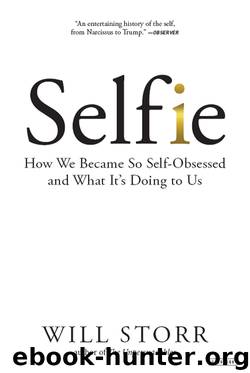Selfie: How We Became So Self-Obsessed and What It's Doing To Us by Will Storr

Author:Will Storr [Storr, Will]
Language: eng
Format: azw3
Tags: SOC002010, PSY031000, PSY008000, HIS054000
ISBN: 9781468315905
Publisher: The Overlook Press
Published: 2018-03-27T04:00:00+00:00
BOOK SIX
The Digital Self
Black screen. Polite applause. A man, Doug Engelbart, appearing in a headset. He wore a black tie, fastened high and tight; his eyes in shadow beneath heavy brows that gave him an air of distance and melancholy. Many of the technology experts in the audience considered Engelbart a ‘crackpot’. They had no idea he had, upon his desk that day, pieces of technology that were as if from a time machine. Engelbart was touching the future, and he was about to show them it.
‘I hope you’ll go along with this rather unusual setting and the fact that I remain seated when I get introduced,’ he said, up on the screen. ‘I should tell you I’m backed up by quite a staff of people between here and Menlo Park where Stanford Research is located, some thirty miles south of here and, er,’ he smiled anxiously and glanced upwards at some unseen person or thing, ‘if every one of us does our job well, it’ll all go very interesting.’ He looked up again. ‘I think.’ Another nervous pause. ‘The research programme that I’m going to describe to you is quickly characterizable by saying if, in your office, you as an intellectual worker were supplied with a computer display backed up by a computer that was alive for you all day and was instantly responsible.’ A glance up. Embarrassment. ‘Responsive. Ha. Instantly responsive to every action you had, how much value could you derive from that?’
What the man on the screen was describing, at the Fall Joint Computer Conference in San Francisco on the morning of Monday 9 December 1968, was a personal computer. To most of the people present this was an utterly novel concept. In the years of the Great Compression, with its collective economy that was so deviant to the American subconscious, a general neurosis had arisen amongst the population that said that computers weren’t there to serve the individual, but the organism. At that time, Silicon Valley was the brain of the military–industrial complex, a place of secretive laboratories working on defence contracts: missiles, radar, guidance, nuclear weaponry. Computers were great humming mainframes, mysterious, alien, basement presences that were operated by teams of inscrutable people in lab coats. They were machines of conformity and control and were to be feared. Even the experts in the Valley, many clustered around Stanford University, saw the future as one in which computers would replace humans, believing true artificial intelligence was coming soon. But Engelbart’s vision was radically different. And so was the technology he was about to demonstrate to the stunned crowd.
The glare from his monitor glowed onto his face as he explained that they’d been developing this new form of computing at the Stanford Research Institute in Menlo Park. ‘In my office I have a console like this and there are twelve others that have computers and we try, nowadays, to do our daily work on here.’ He smiled as if in acknowledgement of how eccentric all this sounded.
Download
This site does not store any files on its server. We only index and link to content provided by other sites. Please contact the content providers to delete copyright contents if any and email us, we'll remove relevant links or contents immediately.
| Anthropology | Archaeology |
| Philosophy | Politics & Government |
| Social Sciences | Sociology |
| Women's Studies |
Born to Run: by Christopher McDougall(7025)
The Leavers by Lisa Ko(6873)
iGen by Jean M. Twenge(5320)
Sapiens by Yuval Noah Harari(5259)
The Kite Runner by Khaled Hosseini(5034)
Spare by Prince Harry The Duke of Sussex(4991)
Bullshit Jobs by David Graeber(3989)
Machine Learning at Scale with H2O by Gregory Keys | David Whiting(3948)
Never by Ken Follett(3698)
Goodbye Paradise(3661)
Livewired by David Eagleman(3619)
Fairy Tale by Stephen King(3150)
Harry Potter 4 - Harry Potter and The Goblet of Fire by J.K.Rowling(2937)
A Dictionary of Sociology by Unknown(2922)
The Social Psychology of Inequality by Unknown(2895)
The Club by A.L. Brooks(2809)
Will by Will Smith(2729)
0041152001443424520 .pdf by Unknown(2722)
People of the Earth: An Introduction to World Prehistory by Dr. Brian Fagan & Nadia Durrani(2672)
